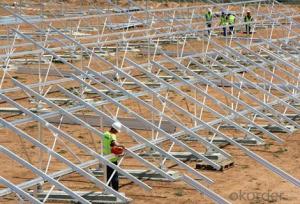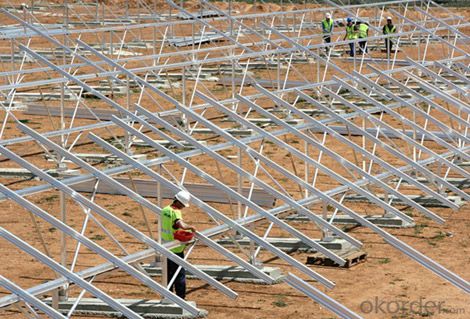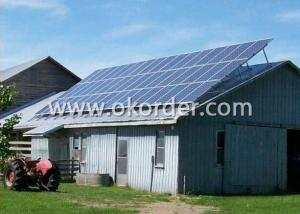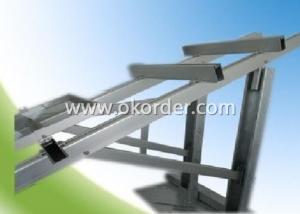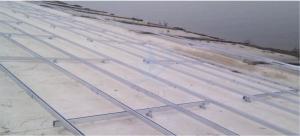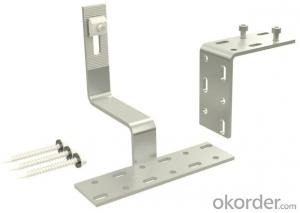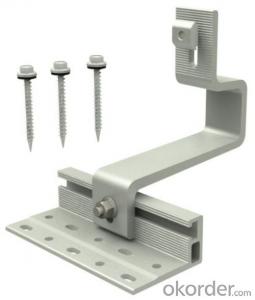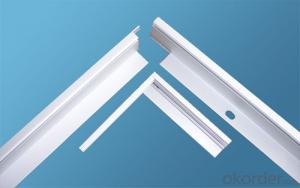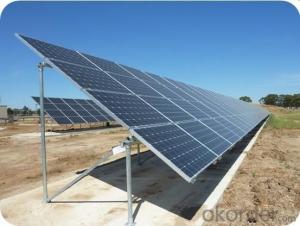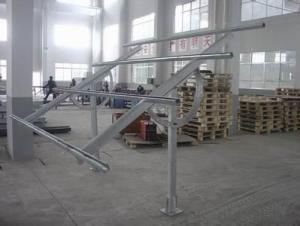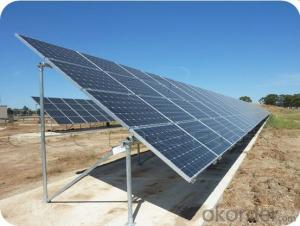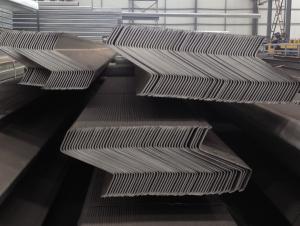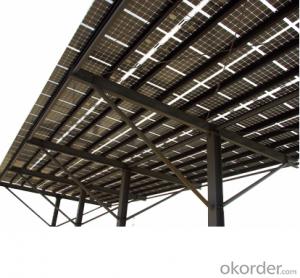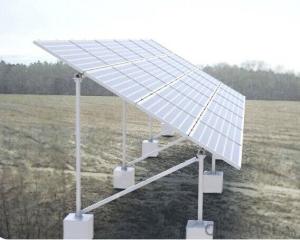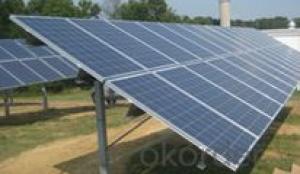Roof Solar Mounting System TT-EC-F55
- Loading Port:
- Shanghai
- Payment Terms:
- TT OR LC
- Min Order Qty:
- -
- Supply Capability:
- 50万套 set/month
OKorder Service Pledge
OKorder Financial Service
You Might Also Like
PV Mounting brackets are special solar photovoltaic systemfor placing, installing, fixing the solar panel design. Generally materials arealuminum, steel structure, stainless steel. PV mounting products at groundmounting system, flat roof mounting system, adjustable angle roof rack system,inclined roof rack system, column bracket system.
The Ground Mounting System including concret basement sysytemand steel pipe sysytem, Titanergy provides total solution for flat or pitchedroof with patent products.On the basis of the given project data, specificnational standards and guidelines, Titanergy will calculate the completestructural analysis and create a complete project plan to make sure reliablestructural safety.We provide high quality HDG steel and aluminum products forthe ground mounting sysytem,witch can make sure the security and durability ofthe project.
Features and Advantages
n The rail bracket is easy to install, just use simple tools(eg, Allen wrench) can be easily installed. Rail connecting member can freelyadjust the length, the stent may be pre-installed on the roof, and thenappropriately adjusted according to the size of the solar panel.
n The combination of strong, aluminum rails and card blocks fora variety of venues and a variety of materials roofs (such as metal, ceramicand other kinds of tile surface)
n Component compatibility, and rail can meet PV modules fromdifferent manufacturers.
n accuracy, the length of the rail to the nearest millimeter,the construction process, not because of the length is too long or too shortfor the second cut.
n flexible assembly, rail hooks can adjust the spacing modulearray and tile has been installed successfully address the uneven roofconstruction led to difficult problems.
n design standards, product design and development process instrict accordance with GB, the German standards and other internationalstandards to ensure products reach the world advanced level.
n Quality assurance, the stent main material is high-qualityaluminum and stainless steel, effectively prevent corrosion of oxidation.Products can be recycled, reducing environmental pollution.
n Carried out strictly according to the current specificnational standards
n Perfectly optimized components and complete structuralanalysis for the sysytem
n High corrosion resisitance ensure the stability and highdurability
n Total test and certification make sure the high quality ofthe products
n Maximum pre-assembled in factory,quick mounting onsite,timesaving
10-year durability warranty
Technical Data
n Design Period:25 years
n Installation Site: Open area
n Array Angle:10°~60°
n ModuleType:Framed or unframed
n Material:Q235B,Al 6063-T5,Al 6005-T5,StainlessSteel A2-70
n Coating:HDG/Anodised
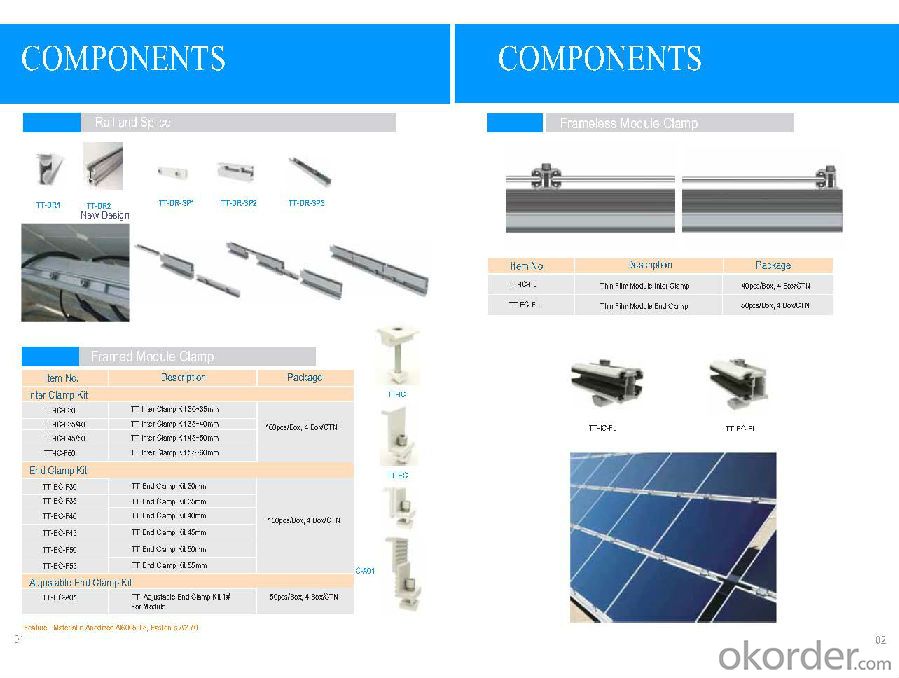

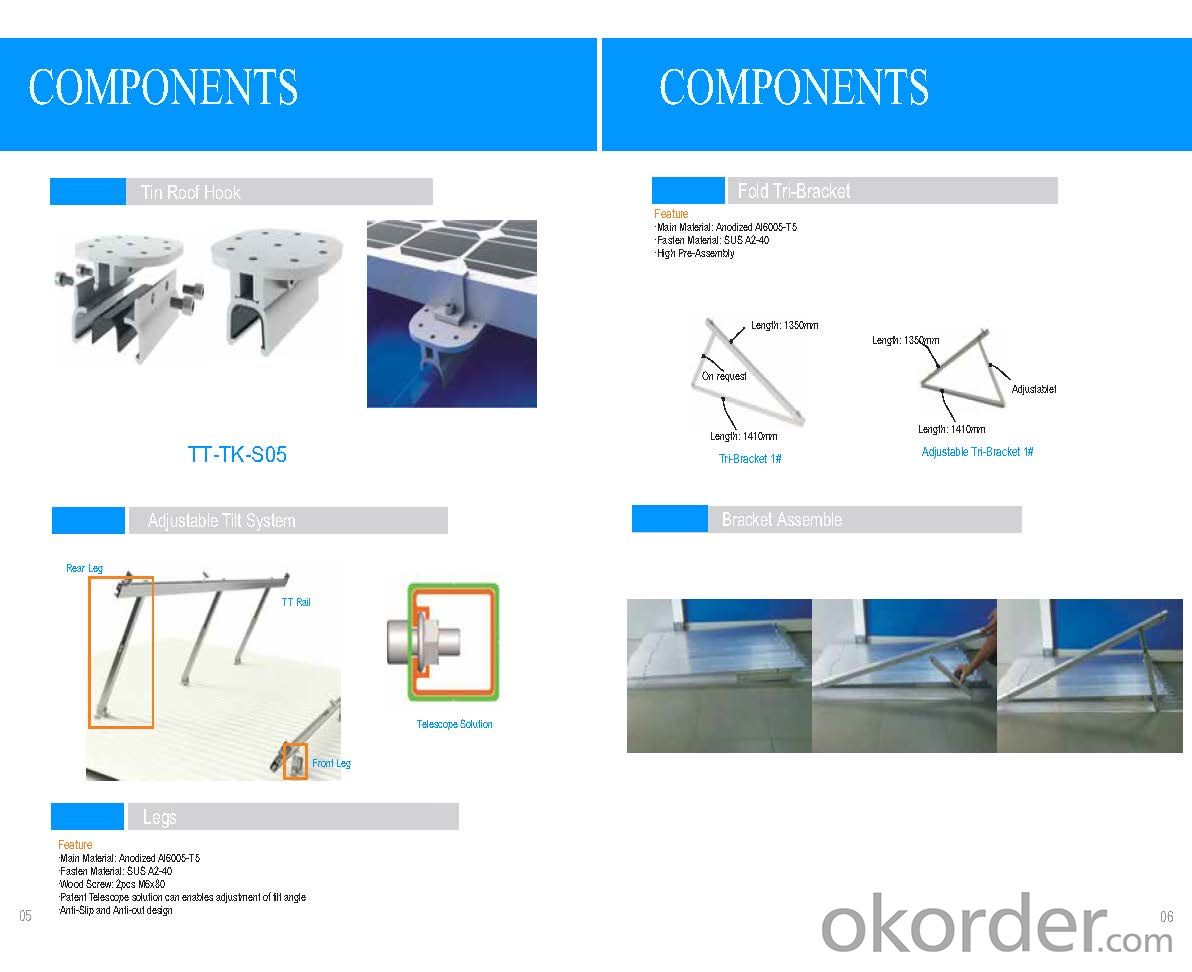
- Q: Are there adjustable solar mounting systems?
- Yes, there are adjustable solar mounting systems available in the market. These systems allow solar panels to be angled and positioned according to the sun's trajectory, maximizing energy generation.
- Q: Can a solar mounting system be used in areas with limited access to regulatory compliance guidelines?
- Yes, a solar mounting system can be used in areas with limited access to regulatory compliance guidelines. However, it is important to note that compliance with local regulations and guidelines is crucial for safety, efficiency, and legal reasons. Therefore, it is recommended to consult with local experts and professionals to ensure proper installation and adherence to applicable regulations even in areas with limited access to guidelines.
- Q: What are the advantages of a ground-mounted solar mounting system?
- A ground-mounted solar mounting system offers several advantages compared to other types of solar installations. Firstly, it allows for optimal positioning and orientation of the solar panels, maximizing their exposure to sunlight and thereby increasing energy generation. Additionally, ground-mounted systems are easier to install and maintain, as they do not require roof penetrations or structural modifications to the building. This makes them suitable for a variety of locations, including sites with limited roof space or those with complex roof structures. Furthermore, ground-mounted systems can be easily adjusted and expanded, allowing for future scalability and flexibility. Finally, ground-mounted installations typically have better airflow around the panels, which helps to keep them cooler and improve their overall efficiency.
- Q: Are there any specific considerations for installing a solar mounting system in a high wind area?
- Yes, there are several specific considerations for installing a solar mounting system in a high wind area. Firstly, the mounting system should be designed to withstand high wind loads by using robust and durable materials, such as galvanized steel or aluminum. Additionally, the system should be securely anchored to the ground or roof structure to prevent any movement during strong winds. It is also important to consider the orientation and tilt angle of the solar panels to minimize wind resistance. Regular inspections and maintenance of the system are crucial in high wind areas to ensure that all components are intact and functioning properly. Overall, careful planning and adherence to wind load calculations and local building codes are essential for a successful solar installation in a high wind area.
- Q: How long does a solar mounting system last?
- A solar mounting system typically lasts for 20 to 25 years.
- Q: Can a solar mounting system be installed on a manufacturing or industrial plant?
- Yes, a solar mounting system can be installed on a manufacturing or industrial plant. These systems are commonly used in such settings to harness solar energy and generate electricity, reducing dependence on traditional power sources and contributing to sustainability efforts. The mounting system can be designed to accommodate the unique requirements and structure of the plant, ensuring a secure and efficient installation.
- Q: Are there any specific requirements for installing a solar mounting system in a coastal area?
- Yes, there are specific requirements for installing a solar mounting system in a coastal area. The system must be designed to withstand the harsh coastal environment, including high winds, saltwater exposure, and corrosive effects. It is important to use materials that are resistant to corrosion, such as stainless steel or aluminum. Additionally, the mounting system should be engineered to withstand potential storm events, ensuring the stability and longevity of the system in coastal conditions.
- Q: Can solar mounting systems be used for both residential and commercial installations?
- Yes, solar mounting systems can be used for both residential and commercial installations. These systems are designed to securely hold solar panels in place, regardless of the size or scale of the installation. Therefore, they are suitable for both residential homes and larger commercial buildings.
- Q: Can solar mounting systems be installed on buildings with limited roof space?
- Yes, solar mounting systems can be installed on buildings with limited roof space. There are various types of solar mounting systems available, including flush-mounted and ballasted systems, which can be customized to fit the specific constraints of a building's rooftop. These systems are designed to maximize the use of available space and ensure efficient installation of solar panels, even in scenarios with limited roof area.
- Q: Are there specific considerations for installing solar mounting systems in different climates?
- Yes, there are specific considerations for installing solar mounting systems in different climates. Some factors to consider include the amount of sunlight and solar radiation available in the specific climate, the temperature variations throughout the year, wind speeds, snow loads, and the presence of extreme weather conditions like hurricanes or heavy rainfall. These factors will influence the design, materials, and installation methods of the solar mounting systems to ensure they can withstand the specific climate and optimize the performance and durability of the solar panels.
Send your message to us
Roof Solar Mounting System TT-EC-F55
- Loading Port:
- Shanghai
- Payment Terms:
- TT OR LC
- Min Order Qty:
- -
- Supply Capability:
- 50万套 set/month
OKorder Service Pledge
OKorder Financial Service
Similar products
Hot products
Hot Searches
Related keywords
